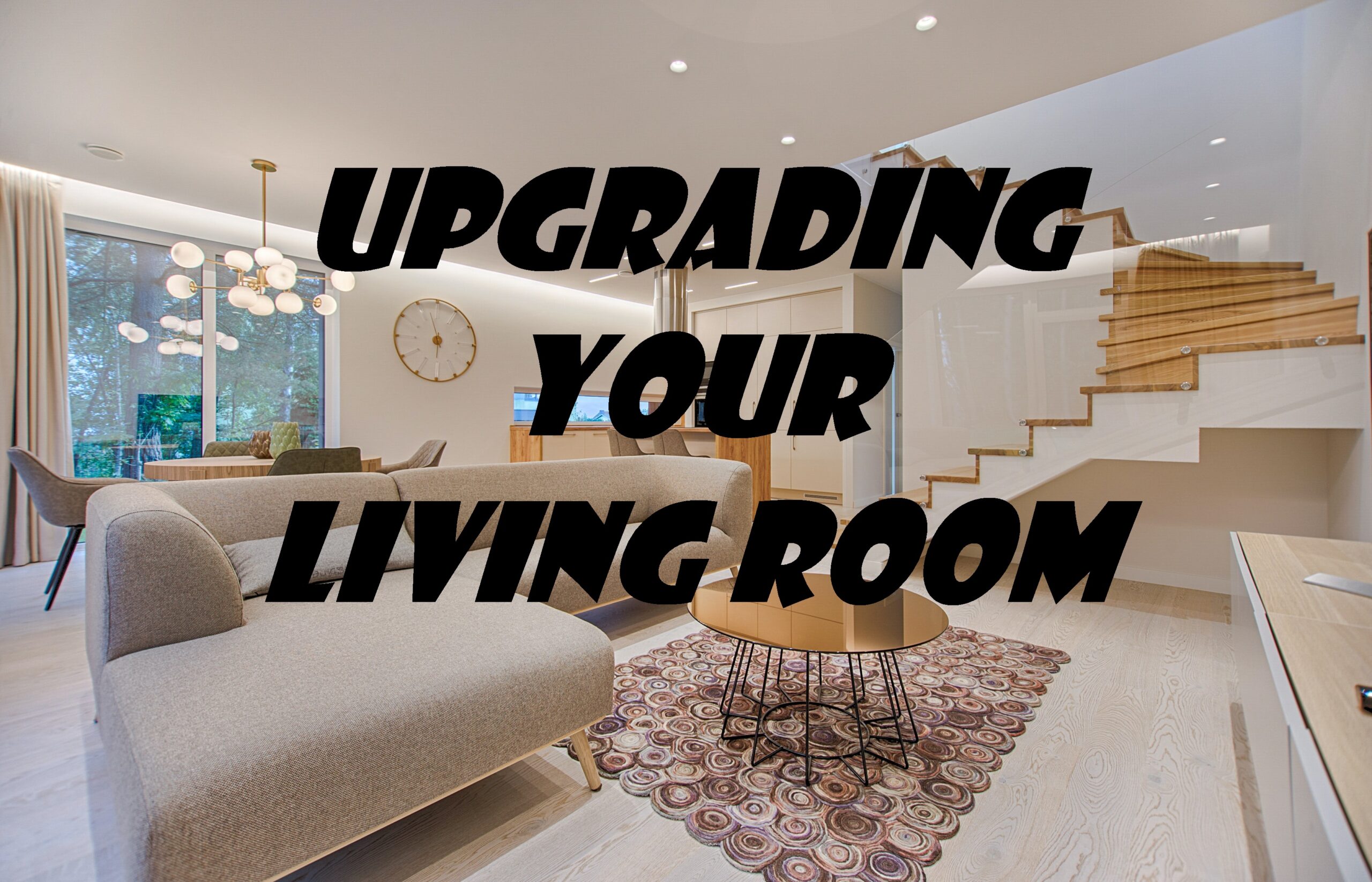Upgrading Your Living Room
***freeDIGIBOOK***Making Your Dream Home a Reality: A Guide to Buying the Perfect Property
Chapter 1: Assessing Your Living Room Needs
Determining your style preferences
Identifying the main purpose of your living room
Measuring the space and creating a floor plan
When it comes to upgrading your living room, it’s important to begin by assessing your needs. This involves taking a close look at your space, your style preferences, and the primary function of the room.
Determining your style preferences:
The first step in upgrading your living room is to determine your style preferences. Do you prefer a traditional, modern, or eclectic style? What colors and patterns do you gravitate towards? What type of furniture do you like? Taking the time to identify your style preferences will help guide you when it comes to choosing furniture, decor, and other elements for your living room.
Identifying the main purpose of your living room:
The next step is to consider the main purpose of your living room. Do you primarily use it for entertaining guests, watching TV, or relaxing? Do you need a space for kids to play or study? Once you’ve identified the main purpose of the room, you can begin to make decisions about furniture and layout that will best suit your needs.
Measuring the space and creating a floor plan:
Before you begin shopping for furniture, it’s important to measure your living room and create a floor plan. This will help you visualize how different furniture pieces will fit in the space and ensure that everything will be to scale. Be sure to measure the length, width, and height of the room, as well as any alcoves or other unique features. Consider where windows and doors are located and how traffic flows through the room. Once you’ve created a floor plan, you can use it as a guide when selecting furniture and accessories.
Overall, taking the time to assess your living room needs before beginning the upgrade process will help ensure that you create a space that is both functional and aesthetically pleasing. By determining your style preferences, identifying the main purpose of the room, and creating a floor plan, you’ll be well on your way to creating the living room of your dreams.
Chapter 2: Setting a Budget
Establishing a budget for the project
Prioritizing expenses based on your needs and wants
Finding ways to save money without sacrificing quality
One of the most important steps in upgrading your living room is setting a budget. Without a budget, it can be easy to overspend and end up with a room that’s not quite what you envisioned. Here are some tips for setting a budget for your living room upgrade:
Establishing a budget for the project:
The first step in setting a budget is to determine how much you can realistically afford to spend on your living room upgrade. Consider your overall financial situation and determine how much you can comfortably allocate towards this project. It’s important to be realistic and not overspend, as this can lead to unnecessary stress and financial strain.
Prioritizing expenses based on your needs and wants:
Once you’ve established a budget, it’s important to prioritize expenses based on your needs and wants. For example, if your main goal is to create a comfortable seating area for family and friends, you may want to allocate more of your budget towards a high-quality sofa and chairs. On the other hand, if you’re primarily interested in creating a stylish, visually appealing living room, you may want to allocate more of your budget towards decor and accessories.
Finding ways to save money without sacrificing quality:
Finally, it’s important to find ways to save money without sacrificing quality. Consider shopping for furniture and decor during sales or using coupons to save money. Look for high-quality pieces that are built to last, as this will ultimately save you money in the long run. You may also want to consider repurposing or refinishing old furniture to save money.
Overall, setting a budget is a critical step in upgrading your living room. By establishing a budget, prioritizing expenses based on your needs and wants, and finding ways to save money without sacrificing quality, you can create a beautiful and functional living room that meets your needs and fits within your budget.
Chapter 3: Choosing the Right Furniture
Selecting comfortable seating options
Deciding on the ideal coffee table or accent table
Finding the perfect entertainment center
Choosing the right furniture is one of the most important aspects of upgrading your living room. Here are some tips for selecting the right furniture pieces:
Selecting comfortable seating options:
Comfort is key when it comes to selecting seating options for your living room. You’ll want to choose pieces that are both comfortable and supportive, with cushions that are firm but not too hard. Consider the size of your living room and how much seating you’ll need. A sofa, loveseat, or sectional can provide ample seating for larger living rooms, while a pair of chairs may be sufficient for smaller spaces.
Deciding on the ideal coffee table or accent table:
A coffee table or accent table can serve as a centerpiece for your living room, so it’s important to choose a piece that not only looks great but also serves a functional purpose. Consider the size and shape of your space when choosing a coffee table, as well as the height of your seating. An ottoman or pouf can also serve as a coffee table in smaller spaces. For accent tables, consider choosing pieces that complement your sofa or chairs and provide additional storage or display space.
Finding the perfect entertainment center:
If your living room doubles as an entertainment space, it’s important to choose an entertainment center that can accommodate all of your electronics and provide ample storage space. Look for an entertainment center with adjustable shelves and cable management features to keep your cords and wires organized. You’ll also want to consider the size of your television and how it will fit within the entertainment center.
When selecting furniture for your living room, it’s important to choose pieces that not only look great but also meet your functional needs. By selecting comfortable seating options, deciding on the ideal coffee table or accent table, and finding the perfect entertainment center, you can create a living room that’s both comfortable and functional.
Chapter 4: Selecting Lighting and Accessories
Understanding the importance of proper lighting
Choosing the right type of lighting for your space
Adding accent pieces to enhance the decor.
The right lighting and accessories can transform your living room into a warm and inviting space. Here are some tips for selecting the right lighting and accessories for your living room upgrade:
Understanding the importance of proper lighting:
Proper lighting is essential when it comes to creating a comfortable and functional living room. It’s important to consider both natural and artificial lighting sources. Natural light can be maximized by using sheer or light-filtering window treatments, while artificial lighting can be used to highlight key features of your living room or create a warm and inviting ambiance.
Choosing the right type of lighting for your space:
When it comes to artificial lighting, there are several types to consider. Overhead lighting, such as recessed lighting or a pendant fixture, can provide ample light for the entire room. Table and floor lamps can provide more focused lighting for specific areas, such as reading or entertaining. You may also want to consider accent lighting, such as wall sconces or under-cabinet lighting, to highlight artwork or architectural features.
Adding accent pieces to enhance the decor:
Accessories can also play a key role in upgrading your living room. Accent pieces, such as throw pillows, blankets, and area rugs, can add texture and color to your space. Wall decor, such as artwork or mirrors, can add visual interest and reflect light. Plants and greenery can bring a natural element into your living room and improve air quality.
When selecting lighting and accessories, it’s important to choose pieces that complement your existing decor and meet your functional needs. By understanding the importance of proper lighting, choosing the right type of lighting for your space, and adding accent pieces to enhance the decor, you can create a living room that’s both beautiful and functional.
Chapter 5: Creating a Focal Point
Identifying the focal point of the room
Adding artwork or a statement piece of furniture to draw attention
Using color and texture to create visual interest.
Creating a focal point is an important aspect of upgrading your living room. It’s the element that draws the eye and sets the tone for the entire space. Here are some tips for creating a focal point in your living room:
Identifying the focal point of the room:
The first step in creating a focal point is to identify the natural focal point of your living room. This may be a fireplace, a large window with a view, or a stunning piece of architecture. If your living room doesn’t have a natural focal point, you can create one with a statement piece of furniture or artwork.
Adding artwork or a statement piece of furniture to draw attention:
Once you’ve identified your focal point, you can add artwork or a statement piece of furniture to draw attention. A large piece of artwork can serve as a focal point, while a statement piece of furniture, such as a unique sofa or accent chair, can also draw the eye. Consider choosing pieces that complement your existing decor and create a cohesive look.
Using color and texture to create visual interest:
Color and texture can also be used to create visual interest and draw the eye towards your focal point. Consider using bold colors or patterns in your artwork or accent pieces. Adding texture, such as a plush rug or woven throw, can also create visual interest and make your focal point stand out.
When creating a focal point, it’s important to choose elements that are both visually appealing and functional. By identifying the focal point of the room, adding artwork or a statement piece of furniture to draw attention, and using color and texture to create visual interest, you can create a living room that’s both beautiful and functional.
Chapter 6: Maximizing Storage
Finding creative ways to add storage to your living room
Incorporating shelves, cabinets, and hidden storage solutions
Organizing your belongings for easy access
Maximizing storage is essential when upgrading your living room. A cluttered and disorganized space can be uninviting and make it difficult to relax. Here are some tips for maximizing storage in your living room:
Finding creative ways to add storage to your living room:
There are many creative ways to add storage to your living room. For example, you can use storage ottomans or poufs as a place to store extra blankets or pillows. A console table with drawers or shelves can provide additional storage space. A storage bench can be used to store toys or games for kids.
Incorporating shelves, cabinets, and hidden storage solutions:
Shelves and cabinets can be used to store books, games, and decorative objects. Consider using floating shelves to display artwork or decorative objects, while cabinets can be used to hide clutter. Hidden storage solutions, such as storage baskets or bins, can be used to keep items out of sight but within easy reach.
Organizing your belongings for easy access:
Once you’ve added storage to your living room, it’s important to organize your belongings for easy access. Consider grouping similar items together, such as books or board games, and labeling storage bins or baskets. Use drawer organizers to keep smaller items, such as remote controls, organized and within easy reach.
When maximizing storage in your living room, it’s important to choose solutions that are both functional and aesthetically pleasing. By finding creative ways to add storage to your living room, incorporating shelves, cabinets, and hidden storage solutions, and organizing your belongings for easy access, you can create a living room that’s both beautiful and functional.
Chapter 7: Choosing the Right Flooring
Selecting flooring that matches your style and budget
Understanding the pros and cons of different flooring types
Installing flooring that will stand the test of time.
The right flooring can make a huge difference in the look and feel of your living room. Here are some tips for selecting the right flooring for your living room upgrade:
Selecting flooring that matches your style and budget:
When it comes to selecting flooring for your living room, it’s important to choose a material that matches your style and budget. Hardwood flooring is a classic choice that adds warmth and beauty to any living room. Laminate and vinyl flooring are more budget-friendly options that can mimic the look of hardwood. Carpeting is also a popular option for living rooms, as it adds softness and warmth to the space.
Understanding the pros and cons of different flooring types:
Each type of flooring has its own pros and cons. Hardwood flooring is durable and timeless, but it can be more expensive and susceptible to scratches and damage. Laminate and vinyl flooring are more affordable and easy to maintain, but they may not have the same warmth and character as hardwood. Carpeting is soft and comfortable underfoot, but it can be more difficult to keep clean and may require frequent vacuuming.
Installing flooring that will stand the test of time:
When installing new flooring in your living room, it’s important to choose a material that will stand the test of time. Look for high-quality materials that are durable and can withstand heavy foot traffic. Consider the maintenance requirements of each type of flooring and choose one that fits your lifestyle and needs.
Overall, selecting the right flooring for your living room is an important aspect of upgrading the space. By selecting flooring that matches your style and budget, understanding the pros and cons of different flooring types, and installing flooring that will stand the test of time, you can create a beautiful and functional living room that meets your needs and fits your budget.
Chapter 8: Incorporating Technology
Adding the latest technology to your living room
Choosing the right television and sound system
Finding smart home solutions that integrate with your lifestyle.
Incorporating technology into your living room can enhance your overall entertainment experience and make your space more functional. Here are some tips for incorporating technology into your living room upgrade:
Adding the latest technology to your living room:
The latest technology can take your living room to the next level. Consider adding features such as a smart speaker, voice-activated assistant, or home automation system to create a more seamless and convenient living experience.
Choosing the right television and sound system:
When it comes to incorporating technology into your living room, the right television and sound system can make a big difference. Choose a television that’s the right size for your space and that has the features you need, such as a smart TV with built-in streaming capabilities. A sound system, such as a soundbar or home theater system, can also enhance your viewing experience and make movies and shows more immersive.
Finding smart home solutions that integrate with your lifestyle:
Smart home solutions can make your living room more functional and convenient. Look for solutions that integrate with your lifestyle, such as smart lighting systems that can be controlled from your phone or a smart thermostat that can be programmed to automatically adjust the temperature based on your schedule.
When incorporating technology into your living room, it’s important to choose solutions that are both functional and easy to use. By adding the latest technology to your living room, choosing the right television and sound system, and finding smart home solutions that integrate with your lifestyle, you can create a living room that’s both comfortable and convenient.
Chapter 9: Creating a Cozy Atmosphere
Using textiles and fabrics to add warmth and comfort
Incorporating plants and greenery to bring nature indoors
Choosing the right scents and fragrances to create a relaxing ambiance.
Creating a cozy atmosphere in your living room can make the space more inviting and comfortable. Here are some tips for creating a cozy atmosphere in your living room:
Using textiles and fabrics to add warmth and comfort:
Textiles and fabrics can add warmth and comfort to your living room. Consider adding throw pillows, blankets, and area rugs to create a cozy and comfortable seating area. Look for fabrics that are soft and inviting, such as wool or cotton.
Incorporating plants and greenery to bring nature indoors:
Plants and greenery can bring a natural element into your living room and make the space feel more inviting. Choose plants that thrive in low-light environments, such as pothos or snake plants, or add a small herb garden to your windowsill. Not only will this add a cozy touch to your living room, but it can also improve indoor air quality.
Choosing the right scents and fragrances to create a relaxing ambiance:
The right scents and fragrances can help create a relaxing ambiance in your living room. Consider using candles or essential oils in scents that promote relaxation, such as lavender or vanilla. You may also want to consider using a diffuser to disperse these scents throughout your living room.
Overall, creating a cozy atmosphere in your living room is all about adding elements that make the space feel warm and inviting. By using textiles and fabrics to add warmth and comfort, incorporating plants and greenery to bring nature indoors, and choosing the right scents and fragrances to create a relaxing ambiance, you can create a living room that’s both cozy and inviting.
Chapter 10: Maintaining Your Living Room
Developing a cleaning and maintenance routine
Protecting your furniture and flooring from damage
Knowing when to update and refresh your living room’s decor.
Maintaining your living room is essential to keep it looking its best and functioning well over time. Here are some tips for maintaining your living room:
Developing a cleaning and maintenance routine:
Regular cleaning and maintenance can help keep your living room looking its best. Develop a routine for cleaning your living room, including dusting, vacuuming, and wiping down surfaces. Consider using a fabric cleaner to remove stains from upholstery or a floor cleaner to keep your flooring looking new.
Protecting your furniture and flooring from damage:
Protecting your furniture and flooring can help extend their lifespan and keep them looking great. Use furniture pads under the legs of your furniture to prevent scratches on your flooring, and consider using coasters to protect your coffee table or accent table from water rings. If you have pets, consider using a protective cover for your furniture to prevent damage from scratches or stains.
Knowing when to update and refresh your living room’s decor:
Over time, your living room’s decor may start to feel outdated or worn. Knowing when to update and refresh your decor can help keep your living room looking fresh and inviting. Consider updating your throw pillows or adding new artwork to your walls. You may also want to consider replacing your area rug or updating your window treatments.
Overall, maintaining your living room is essential to keep it looking its best over time. By developing a cleaning and maintenance routine, protecting your furniture and flooring from damage, and knowing when to update and refresh your living room’s decor, you can create a living room that’s both beautiful and functional for years to come.
Conclusion:
Summing up the key takeaways from the guide
Encouraging readers to put their knowledge into action
Inspiring readers to enjoy their newly upgraded living space.
Congratulations! By following this guide, you should now have a better understanding of how to upgrade your living room and create a space that’s both beautiful and functional. Here are some key takeaways from this guide:
Assessing your living room needs is an important first step in the upgrade process. Understanding your style preferences, identifying the main purpose of your living room, and measuring the space can help you create a plan that meets your needs and fits your budget.
Setting a budget and prioritizing expenses can help you make the most of your living room upgrade. Finding ways to save money without sacrificing quality can also help you achieve your goals.
Choosing the right furniture, lighting, flooring, and accessories can enhance the look and functionality of your living room. Creating a focal point, maximizing storage, incorporating technology, and creating a cozy atmosphere can also make a big difference.
Maintaining your living room is essential to keep it looking its best over time. Developing a cleaning and maintenance routine, protecting your furniture and flooring from damage, and knowing when to update and refresh your decor can help you enjoy your living room for years to come.
Now that you have the knowledge, it’s time to put it into action! Take the steps necessary to upgrade your living room, and enjoy the benefits of a beautiful and functional space. Remember, your living room is a place where you can relax and spend time with family and friends. By creating a space that meets your needs and fits your style, you can enjoy your newly upgraded living space to the fullest.




